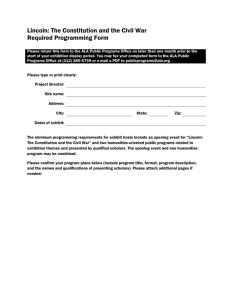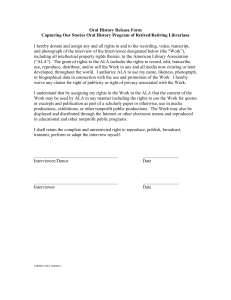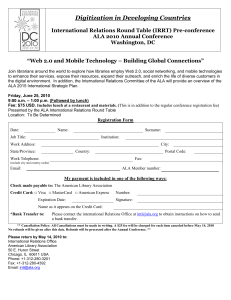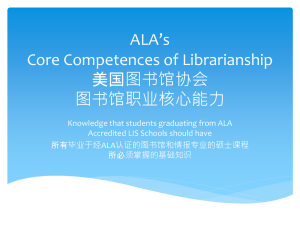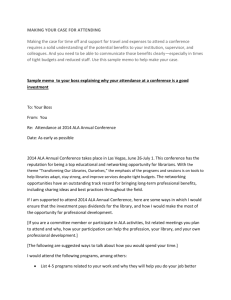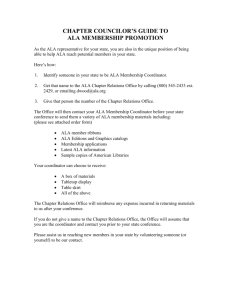outrage and willful conduct cases
advertisement
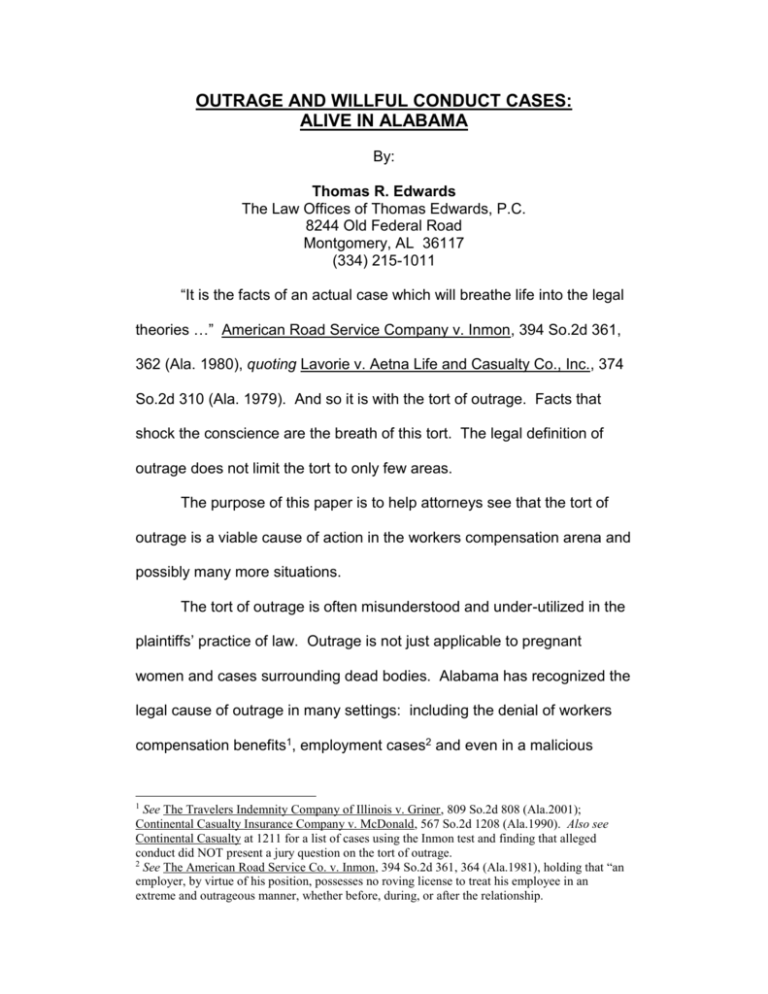
OUTRAGE AND WILLFUL CONDUCT CASES: ALIVE IN ALABAMA By: Thomas R. Edwards The Law Offices of Thomas Edwards, P.C. 8244 Old Federal Road Montgomery, AL 36117 (334) 215-1011 “It is the facts of an actual case which will breathe life into the legal theories …” American Road Service Company v. Inmon, 394 So.2d 361, 362 (Ala. 1980), quoting Lavorie v. Aetna Life and Casualty Co., Inc., 374 So.2d 310 (Ala. 1979). And so it is with the tort of outrage. Facts that shock the conscience are the breath of this tort. The legal definition of outrage does not limit the tort to only few areas. The purpose of this paper is to help attorneys see that the tort of outrage is a viable cause of action in the workers compensation arena and possibly many more situations. The tort of outrage is often misunderstood and under-utilized in the plaintiffs’ practice of law. Outrage is not just applicable to pregnant women and cases surrounding dead bodies. Alabama has recognized the legal cause of outrage in many settings: including the denial of workers compensation benefits1, employment cases2 and even in a malicious 1 See The Travelers Indemnity Company of Illinois v. Griner, 809 So.2d 808 (Ala.2001); Continental Casualty Insurance Company v. McDonald, 567 So.2d 1208 (Ala.1990). Also see Continental Casualty at 1211 for a list of cases using the Inmon test and finding that alleged conduct did NOT present a jury question on the tort of outrage. 2 See The American Road Service Co. v. Inmon, 394 So.2d 361, 364 (Ala.1981), holding that “an employer, by virtue of his position, possesses no roving license to treat his employee in an extreme and outrageous manner, whether before, during, or after the relationship. prosecution case!3 However, even these situations are not exclusive. Outrage can take place in an endless number of circumstances. Outrage is outrage, no matter where it occurs. It doesn’t matter which area of the law the case falls under, only that the following elements of outrage can be proven: 1) The actor intended to inflict emotional distress, or knew or should have known that emotional distress was likely to result from his conduct; 2) The conduct was extreme and outrageous; and 3) The distress was severe. Moore v. Spiller Associated Furniture, Inc., 598 So.2d 835, 836 (Ala.1992) citing Perkins v. Dean, 570 So.2d 1217, 1219 (Ala.1990) In other words, a cause of action for outrage can arise under an infinitive number of facts and circumstances. Nothing in this definition limits this tort to only a narrow range of cases. The cornerstone of an outrage case is whether the conduct complained of “shocks the conscience” of the public and whether the conduct was willful. The first time I brought a claim for outrage was involving a murder for hire situation. The tortfeasor hired hit-men to have my client killed because the client filed a lawsuit against the guy. Clearly, the act of hiring someone to kill another person shocks my conscience. It also shocked the trial judge. The Defendant filed a motion for summary judgment based 3 National Security Fire & Casualty Company, et al., v. Stanley R. Bowen, 447 So.2d 133 (Ala 1984), upheld a $1,500,000.00 verdict holding that actions of insurance company agents arising from an investigation of fire loss which resulted in the prosecution of the plaintiff for arson and false pretenses was so horrible, so atrocious, so barbaric, that the jury could find as a mater of fact that the plaintiff suffered severe emotional distress and that no civilized person could be expected to endure the acts committed without suffering mental distress. 2 on the argument that the Supreme Court had not recognized the tort of outrage in murder-for-hire fact situations. The trial court disagreed with this contention and stated that the citizens of his circuit elected him to use his plain and ordinary judgment in applying the law to the facts of the cases presented before him. The law does not wait on the Supreme Court. The law is applied and brought to life at the trial court level. “It is the facts that breathe life into legal theories.” The tort of outrage, or intentional infliction of severe emotional distress, was first recognized in American Road Service Co. v. Inmon, 394 So.2d 361 (Ala.1980), wherein the Court stated: Willful wrongs, or those made so recklessly as to equate willfulness, authorize recovery in damages for the mental suffering caused thereby, and we now recognized that one who by extreme and outrageous conduct intentionally or recklessly causes severe emotional distress to another is subject to liability for such emotional distress and for bodily injury resulting from the distress. The emotional distress … must be so severe that no reasonable person could be expected to endure it. Any recovery must be reasonable and justified under the circumstances, liability ensuring only when the conduct is so outrageous in character and so extreme in degree as to go beyond all possible bounds of decency, and to be regarded as atrocious and utterly intolerable in a civilized society. American Road Service Co. v. Inmon, 394 So.2d 361 (Ala.1981) (citing Comment (d) Restatement (Second) Torts, §46 (1965)). The Courts have said that tort of outrage does not recognize recovery for “mere insults, indignities, threats, annoyances, petty oppressions, or other trivialities.” American Road Service Co. v. Inmon, 394 3 So.2d 361 (Ala. 1981), citing Comment, Restatement (Second) Torts §46 (1948). The statutory period of limitations for the tort of outrage is two years. Section 6-5-38 Alabama Code (1975); Archie v. Enterprise Hospital & Nursing Home, 508 So.2d 693 (Ala.1987); Edison v. JohnsRidout’s Chapels, Inc., 508 So.2d 697 (Ala.1987). However, in many cases the outrageous behavior is not an isolated event and occurs over an extended period of time. The recalcitrance of the bad actor can at some point crossover to outrageous conduct, thus showing the continuing nature of the tort. It is often a course of conduct that exhibits outrageous behavior. A “continuous tort” which arises from continuing dealings between the parties, will not be barred until two years after the last tortuous act by the defendant, particularly where the defendant’s conduct does not cross the threshold and become an actionable tort until it is demonstrably extreme and outrageous. Continental Casualty Insurance Company v. McDonald, 567 So.2d 1208 (Ala. 1990), citing Garrett v. Raytheon Co., 368 So.2d 516 (Ala.1979). OUTRAGE AND WILLFUL CONDUCT IN WORKERS COMPENSATION CASES The exclusivity provisions of the Workers Compensation Act does not bar a worker’s claim for outrage. Sections 25-5-11, 25-5-52 and 25-553, Alabama Code (1975). See also Garvin v. Shewbart, 442 So.2d 80 (1983). 4 The Worker’s Compensation Act is designed to compensate those who are injured on the job and provides immunity from common law suits for those employers and carriers who come within the Act. A suit seeking recovery under the tort of outrageous conduct does not seek compensation for medical benefits for the original on-the-job injury. The connection with the physical injury that gave rise to the original workmen’s compensation claim is tenuous. The conduct giving rise to the tort of outrageous conduct in the context of this kind of case can be more accurately characterized as mental assault than as a failure to pay compensation of medical benefits even though it may arise in a failure to pay context. Conduct constituting the tort of outrageous conduct cannot reasonably be considered to be within the scope of the Act. When the employer or carrier’s conduct crosses the line between mere failure to pay and intent to cause severe emotional distress, the cloak of immunity is removed. Stewart v. Matthews Industries, Inc., 644 So.2d 915 (Ala. 1994) citing Garvin v. Shewbart, 442 So.2d 80, 83 (Ala.1983). The Alabama Supreme Court has recognized the tort of outrage in the context of the handling of workers compensation claims. The Court has in the past affirmed judgments based upon finding the defendant had committed the tort of outrage when a workers compensation carrier or third-party administrator purposely withheld Workers Compensation medical benefits, medication, or referral to another physician as part of a design to force an end of the claim -- to close the claim file and quit spending money, mainly by coercing a minimal settlement of medical benefits. See also Travelers Indemnity Co. Of Illinois v. Griner, 809 So.2d 808 (Ala. 2001); Continental Cas. Ins. v. McDonald, 567 So.2d 1208 (Ala. 1990). However, “the failure to authorize a referral alone does not amount to conduct so outrageous in character and so extreme in degree as to go 5 beyond all possible bounds of decency, and to be regarded as atrocious and utterly intolerable in a civilized society.” Soti v. Lowes Home Centers, Inc., 906 So.2d 916 (Ala. 2005) citing ITT Specialty Risk Services Inc. v. Barr, 842, So.2d 638,645 (Ala.2002) quoting Inmon, supra at 365. Cases have held that an employee may bring a claim for outrage against the compensation carrier4, the employer5 or a co-employee6. Section 25-5-11, Code of Alabama (1975), clearly allows claims for willful conduct (for which outrage is one form) against third party administrators and Workers Compensation adjusters, as well. In Continental Casualty Insurance Company v. McDonald, 567 So.2d 1208 (Ala. 1990), the Court upheld a damages award of $750,000.00 in favor of the Plaintiff wherein it was found that the defendant’s Workers Compensation carrier engaged in a deliberate effort 4 See Garvin v. Shewbart, 442 So.2d 80 (Ala. 1983). See also Jenkins v. U.S. Fidelity and Gar. Co., 698 So.2d 765 (Ala. 1997); Jones v. Crawford & Co., 693 S.2d 454 (Ala. Civ. App. 1995) reversed on other grounds Ex Parte Crawford & Co., 693 So.2d 458 (Ala. 1997); Ex Parte Lumbermen’s Underwriting Alliance, 662 So.2d 1133 (Ala. 1995); Stewart v. Matthews Industries, Inc., 644 So.2d 915 (Ala. 1994); Brooks v. Liberty Mut. Ins. Co., 1994 U.S. Dist. LEXIS (S.D. Ala. 1994); Gibson v. Southern Guar. Ins. Co., 623 So.2d 1065 (Ala. 1993); Farley v. CAN Ins. Co., 576 So.2d 158 (Ala. 1991); Continental Cas. Ins. Co. v. McDonald, 567 So.2d 1208 (Ala. 1990); Nabors v. Travelers Ins. Co., 551 So.2d 308 (Ala. 1989); Oliver v. Liberty Mut. Ins. Co., 548 So.2d 1025 (Ala. 1989); Nabors v. St. Paul Ins. Co., 489 So.2d 573 (Ala. 1986); Moore v. Liberty Mut. Ins. Co., 468 So.2d 122 (Ala. 1985); Gibson v. Fidelity and Cas. Co. of New York, 454 So.2d 526, 531 (Ala. 1984) overruled on other grounds, Lowman v. Piedmont Executive Shirt Mfg., Co., 547 So.2d 90 (Ala. 1989). 5 See, e.g., Smith v. Scott Paper Co., 620 So.2d 976 (Ala. 1993); Lowman v. Piedmont Executive Shirt Mfg. Co., 547 So.2d 90 (Ala. 1989); Glenn v. Vulcan Materials Co., 534 So.2d 598 (Ala. 1988) overruled on other grounds Lowman v. Piedmont Executive Shirt Mfg. Co., 547 So.2d 90 (Ala. 1989); Garnett v. Neumann, 507 So.2d 496 (Ala. 1987) overruled on other grounds Lowman v. Piedmont Executive Shirt Mfg. Co., 547 So.2d 90 (Ala. 1989). 6 See Lowman v. Piedmont Executive Shirt Mfg. Co., 547 So.2d 90, 95 (Ala. 1989); Garnett v. Neumann, 507 So.2d 496 (Ala. 1987) overruled on other grounds Lowman v. Piedmont Executive Shirt Mfg. Co., 547 So.2d 90 (Ala. 1989); Glenn v. Vulcan Materials Co., 534 So.2d 598 (Ala. 1988) overruled on other grounds Lowman v. Piedmont Executive Shift Mfg. Co., 547 So.2d 90 (Ala. 1989). 6 to cause McDonald to suffer severe emotion distress in order to coerce acceptance of an unreasonably low lump-sum settlement. The carrier systematically withheld payments in order to cause McDonald anguish over the possibility of the cessation of medical treatments for his pain and thereby to cause him to accept a method of payment that would not subject him to the carrier’s “aggravation” as he called it. The Continental Casualty Court went on to say: This Court further recognizes that the nature of the Alabama Worker’s Compensation Act requires that employees who fall within the protection of these statutes have confidence that their medical bills will be timely paid, and to deter defendants from future conduct such as was evidenced here when paying medical bills owed under our compensation laws. Indeed, the guarantee of payment of future medicals is a major factor considered by injured employees when settling their workers compensation claims. Continental Casualty at 1222. In the Travelers Indemnity Company of Illinois v. Griner case, the Alabama Supreme Court upheld an award of $300,000.00 in compensatory damages and $200,000.00 in punitive damages against an insurer who withheld payment for reasonable and necessary medical treatment under the terms of settlement. Travelers Indemnity Company of Illinois v. Griner, 809 So.2d 808 (Ala. 2001). In Griner, an employee, Griner, sustained serious on-the-job injuries. Griner at 809. However, the employer's Workers Compensation carrier and claims administrator either delayed payment or refused payment altogether for Griner's reasonable and necessary medical expenses. Specifically, funds to provide certain 7 necessary medical devices as well as treatment for depression were denied for approximately five years. The defendants knew that they were obligated to provide those devices and treatment and knew that Griner was in pain, but continued to deny this care in an effort to pressure Griner to agree to a nominal settlement. Griner at 811-2. This Court held that the defendants' actions were sufficient to support a jury's finding that their conduct was extreme and outrageous. Griner at 812. One element of a workers compensation outrage appears to be essential and that is the outrage must be part of a broader attempt to settle or close out medical benefits. See Soti v. Lowes Home Centers, Inc., 906 So.2d 916 (Ala. 2005). The appeal courts have not found outrage without this element, but the courts may not have seen the right case yet. WILLFUL CONDUCT When dealing with outrage in a Workers Compensation case, a claim for willful conduct, pursuant to Section 25-5-11, may be applicable. Willful conduct is shown by the circumstances. A design to injure another is going to be a part of an outrage scheme when physical injury results. Under Workers Compensation, the aggravation or exacerbation of a pre-existing medical condition is generally recognized as creating a new compensable injury. See Ex parte Pike County Comm’n, 740 So.2d 1080 (Ala. 1999), and Hooker Const., Inc., v. Walker, 825 So.2d 838 (Ala. Civ. App. 2001). When 8 an adjuster pursues a course of conduct that deliberately denies authorization (without reasonable justification) for causally related, reasonable, and necessary medical treatment that was repeatedly requested by the authorized treating physician and knowingly recognizes that the claimant is in need or peril, then a claim for willful conduct arises if the claimant’s medical condition is made worst, aggravated, or exacerbated. Section 25-5-11, Code of Alabama (1975, as amended), states that “the injured employee, or his or her dependants in the case of death, may bring an action against any workers’ compensation insurance carrier of the employer or any person, firm, association, trust, fund, or corporation responsible for servicing and payment of workers’ compensation claims for the employer …, only for willful conduct which results in the or proximately causes the injury or death.” Willful conduct is defined in the statute, among other things, as: “A purpose or intent or design to injure another; and if a person with knowledge of the danger or peril to another, consciously pursues a course of conduct with a design, intent, and purpose of inflicting injury, then he or she is guilty of ‘willful conduct.’” What is willfulness? Alabama Pattern Jury Instruction 29.01 defines Willfulness as follows: Willfulness is the conscious doing of some act or omission of some duty under knowledge of existing conditions accompanied with a design or purpose to inflict injury. In “willful conduct” and “willful injury” a purpose or intent or design to injure is an ingredient; and where a person, with knowledge of the danger or peril to another consciously 9 pursues a course of conduct with a design, intent, and purpose of inflicting injury, then he is guilty of willfulness. Based on this definition, willful conduct is a close cousin of outrage in a Workers Compensation situation. It is obvious that when an injured employee is denied medical treatment his or her condition will get worst. Without pain treatments, the pain will grow and the person will become debilitated. Without corrective surgery, an injured joint will deteriorate. In each case, the pre-existing condition is made worst, aggravated and/or exacerbated. A new injury occurs. Consequently, when an adjuster consciously and deliberately denies needed medical treatment and the employee get worst, then the adjuster may have committed willful misconduct under Section 25-5-11. FACTORS TO LOOK FOR WHEN EVALUATING AN OUTRAGE OR WILLFUL CONDUCT CASE An outrage case or willful conduct is a mosaic of evidence -- little facts placed together that bring about a picture of willful misconduct that can only be designed to harm someone. The burden of proof is heavy as with all intentional torts. Clear and convincing evidence is required to prove punitive damages and to, sadly, overcome a motion for summary judgment. However, if it shocks your conscience, it will probably shock the judge as well. As in other intentional torts, the elements of outrage may be proved by circumstantial as well as direct evidence. See Vincent v. Blue Cross- 10 Blue Shield of Alabama, 373 So.2d at 1064-65. Just like proving knowledge in a wantonness claim, “The actor’s knowledge may be proved by showing circumstances from which the fact of knowledge is a reasonable inference; it need not be proved by direct evidence.” Scott v. Villegas, 723 So2d 642, 643 (Ala. 1998), quoting Hame v. CSX Transp., Inc., 621 So.2d 281, 283 (Ala. 1993). Let’s face it, who is going to admit that they intentionally harmed someone? And it is almost impossible to find that document that states that the defendant had a plan to harm your client. It is the pieces of the puzzle that make up the picture. This is an occasion where other acts or wrongs are most helpful to proof motive, intent, plan, knowledge or absence of mistake. See Gamble’s Alabama Rules of Evidence 404(b). Again, these cases are proven by circumstantial evidence. However, they are made great by the arrogance of the adjuster in the obstinate denial of benefits. When looking at a potential case, pay attention to the following: 1) Often what your client says seems so off the wall, you say to yourself this can not possibly be right. “Surely there must be a reasonable explanation.” For this reason, I recommend my clients to write the adjuster (in a workers’ compensation case) and ask for an explanation or change in heart. If it is a simple misunderstanding, then this should clear it up and everyone can move on. 2) What is the adjuster’s attitude? Is he or she rude? Arrogant? Unrelenting? Recalcitrant? 3) Do the medical records support the adjuster’s position? What does the authorized treating physician say? Has the doctor written the company and explained the medical necessity of the requested treatment? Has this gone to 11 utilization review (remember most utilization review doctors are there for a purpose to deny claims)? 4) Is there a pattern of wrongful conduct, i.e., delaying or denying payments or withholding medical treatment without justification through out the claim’s history or did denials only suddenly appear? 5) Is there a reasonable explanation for the company’s position? Are they stating it in their correspondence? 6) How long has this been going on? 7) What are the specific wrongful acts? 8) Does this smell right? 9) Did the Plaintiff participate in any wrongful conduct during the course of the relationship or employment? 10) Is the client a whiner? PREPARING THE PLAINTIFF FOR A FIGHT An outrage case is a fight to the finish. Defendants do not settle these cases easily, unless they have been hit before. Everything is a fight. Discovery is difficult to obtain. It is difficult to know whether you have gotten all the documents. Claims files are voluminous. They may be out of order. Tons of duplicate copies of documents will be found. The scheduling of depositions of adjusters and corporate representatives becomes a hassle. A motion for summary judgment is coming and must be addressed with substantial evidence. Motions in limine come rolling in. The work involved is substantial. These cases cannot be handled in a cheap manner in either time or money. 12 Outrage and willful conduct are difficult causes of action to prove; you must prepare your client for the uphill battle. Both of these causes of action are fraught with volatile emotions from both sides. Plaintiffs who are victims of outrage and willful conduct are emotionally vested in these types of cases -- usually because the cases have occurred over a long period of time. Common in outrage and willful conduct cases is when the defendant tries to “wear down” the plaintiff -- force him/her to settle the claim or ignore them for long periods of time hoping the plaintiff will just give up. These cases can become highly adversarial and you must prepare you client for the fight ahead. Defendants are outraged you would even accuse them of this type of behavior. They just don’t get it. Often defendants will try to portray that they were nice in their letters. Just remember the biggest betrayal of all time was committed with a kiss! Also, defendants want to blame the plaintiff or his/her attorney for the situation. Be ready to be blamed for someone else’s bad behavior. THE PAPERWORK Take the time to pour through every piece of discovery -- two or three times. Catalog it and get organized! It is vital that you know what documentary evidence you have or do not have. The proof of outrage and willful conduct against insurance companies and corporations will be found in the defendant’s own files, if you look closely enough. Also, you 13 need to pay attention to what is NOT in the file. Insurance companies live by the old adage “if it’s not written down, then it didn’t happen.” A Catch22 arises for the defendant when the file is silent to action that should have been taken. What is NOT noted in the file can be just as important as what is in the file. Make a visual aid to help in the presentation of the documentary evidence and for use with each witness at trial. A timeline of the “paper trail” is essential and also needs to be made into a visual aid at trial. CONCLUSION The tort of outrage is not a cookie cutter cause of action. Is what that is happening to your client shocking? If so, then you may have outrage. Is there any reasonable justification for the other party’s behavior? If not, then file. You may be surprised as to what is in the files and what is not. Often when you peal the case back, there is no reasonable explanation but outrage and/or willful conduct. OUTRAGE AND WILLFUL CONDUCT -seminar 14
